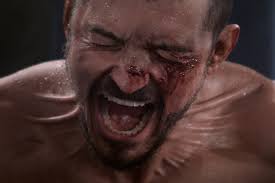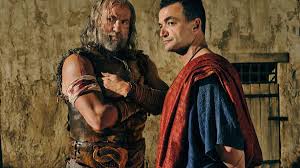The Cut 2024 Movie Review
Anybody who came of age during peak Orlando Bloom — when the British actor became an impossibly pretty early 2000s sex symbol as the long-haired Legolas in “Lord of the Rings” or the swashbuckling Will Turner in “Pirates of the Caribbean” — will likely get a bit of whiplash watching the actor’s left-turn pivot in “The Cut.” A sports drama with traces of body horror in its veins, director Sean Ellis’ film roughs up Bloom’s spotless face with some prosthetics (seamlessly done by make-up designer Mark Coulier) to play an unnamed retired Irish boxer desperate for a second chance at stardom.
Private school educated and longterm partner of Katy Perry, Bloom isn’t exactly a natural choice for such a down-and-out type, but the broken nose and droopy eyelids he puts on do successfully dispel most of his inherent movie star glamor. And yet, watching the film, there’s something missing from his performance — an inner intensity, a hunger — to convince as much as all the makeup, and deepen the often upsetting story of punishing your own body in pursuit of greatness into something more compelling.
Beginning with a quick glimpse at the last major bout of the boxer’s career, before an injury led to him being cast out of the glitzy world of Las Vegas prize fights, “The Cut” quickly lays out the more humble life he’s built for himself in the years since. On the one hand, there’s a loving relationship with his partner and former trainer Caitlin (Caitríona Balfe, convincing if woefully underserved in a typical “concerned spouse” role), running their own gym where they offer lessons to kids, and having enough local hero clout that there are still younger students begging their moms to snap pictures with him. On the other hand, there’s the mouthy and disrespectful teenagers he has to deal with, and a gnawing sense that he could have had and maybe deserved something greater.
So, when promoter Donny (Gary Beadle, overdoing the shadyness by a hair) shows up with an offer to step in for a fighter who died unexpectedly before a big title fight, the boxer is desperate enough for another shot that he jumps at the offer despite all of the warning signs. Chief among them being: the weight cut off to be eligible is a flat 154 pounds. As Caitlin pries out of him when he tries to evade the question, he’s currently hovering around 186, and has about a week to shed the fat to qualify.
Although you might initially expect “The Cut” to speed through this complication with a training montage to get to the boxing, it soon becomes clear that the battle to shed the pounds is the actual fight the movie is concerned with. In their anonymous Vegas hotel, Caitlin and the boxer’s team puts the athlete to work, putting him on a diet of protein and salads while he undergoes constant training in a foolhardy effort to get the weight down quick and fast. It’s obvious from a very early point that there’s no way that this could end healthily, but the boxer is too concerned with the futile promise of the title to pay that much attention, and Ellis dramatizes the psychological toll that the crash-diet and excessive routine has with patience and a compelling hint of horror.
The warning signs pop up early but infrequently: Visions of blood seeping out of meat, flashes of figures from the boxer’s past appearing in hallways as his brain suffers from the toil he’s putting on his body. Particularly upsetting and painful are the scenes where Bloom binges and purges, swallowing a candy bar before barfing it back down the toilet. Desperate to shed the pounds, he alienates his team and especially Caitlin by taking on Boz (John Turturro, wickedly fun in a role he could probably play in his sleep), a trainer notorious for pushing his proteges to their limit and engaging in dubiously ethical techniques. Putting it bluntly during his initial meeting, Boz says he sees the boxer “as nothing but a poker chip,” which is part of why he gets hired; Caitlin cares too much to get the results that are needed.
“The Cut” works best as a purely visceral experience, as a dig into the physical and psychological hell that Boz pushes Bloom’s character into. Ellis shoots the world of the film with a dark and dreary workmanlike sheen (Vegas has never been less glamorous than it is here), but is willing to make nauseating pivots into dreamlike horror. The boxer starts seeing flashes of the far more famous opponent he’s fighting out of the corner of his eye; people’s faces appearing splattered in blood like demons in dark green lighting, and the entire world becomes hazy and out of focus. These moments of visual flourish are welcome, and one can imagine a version of “The Cut” that leans in more to the surreality to disquieting effect.
Unfortunately, though, “The Cut” doesn’t go all the way with it, and too often rests upon its bare bones storyline. The main problem lies in the script, credited to Justin Bull and based on a story by Mark Lane. It too often renders the conflict a little too neatly, with blunt dialogue and shallow characterization for its entire cast; particularly frustrating is the relationship between Caitlin and the boxer, which should be the emotional center of the film but never really lights into anything lived-in or real despite Balfe’s valiant efforts.
Black and white flashbacks to the boxer’s youth as a child during the Troubles aim to flesh out the lead’s obsessive quest for his final shot but only dillutes it instead, reducing his motivations to trite trauma and mother issues. As the boxer breaks down further — taking pills, getting blood transfusions to suck away the smallest ounces of weight away — the film builds to a legitimately stomach-turning climax, only to frustratingly end on a note of ambiguity that feels neither like a hopeful relief nor a fittingly tragic outcome.
Or maybe the ending would register more with another actor in the part. Bloom is functional enough as the boxer, but he doesn’t add more to the film than what’s on the page. Compared to Balfe or Turturro, who are never less than engaging and believable in their side parts, the star never convincingly sinks into the role, or embodies the pain and anger driving the unnamed man to make him more than just a cypher. His facial transformation aside, Bloom doesn’t ever seem to find the physicality needed for a film so concerned with flesh and bone. It’s easy to imagine a performer more attuned to deliver intense, driven performances unlock the full potential of this character. As it is, “The Cut” never quite cuts as deep as you want it to.




